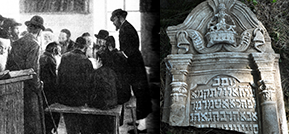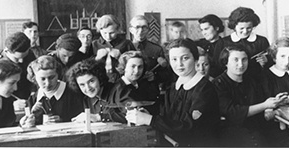During the First World War, Bohorodchany was occupied by the Russian army in 1915. An intense battle took place in the town itself and the front line went for some time along the Bystritsa Solotvinska River ("Istoriia Bohorodchaniv," 83). As a result of the fighting and poor conditions, typhus and cholera epidemics broke out in the region (Momot, "Istoriia Bohorodchaniv"). The Russian occupation was a disaster for the Jews of Bohorodchany, like other places in Galicia. The Russian Cossack forces entering the town perpetrated an anti-Jewish pogrom. Several Jews, including children, were murdered, women were raped, and a large amount of property was plundered. Several women were brutally raped in a synagogue where they sought refuge (Pinkas Hakehilot, 71; CAHJP, HM2/9446.4).
At the end of the war, Bohorodchany became part of the short-lived West Ukrainian People's Republic, the capital of which was situated in Stanislawow. However, in May 1919 the town was conquered by the Polish army. After an unsuccessful attempt by the Red Army to conquer Galicia during the Soviet-Polish War of 1920 the region became a part of the newly established independent Polish State.
During the wars of 1915-1921, the population of Bohorodchany dropped significantly. According to the Polish census of 1921, there were only 2,615 residents in the town, of them 1,286 Greek Catholics (Ukrainians), 730 Jews, 593 Roman Catholics (mostly Poles), and 6 Protestants (Germans) (Misto Bohorodytsi, 6; Momot, "Istoriia Bohorodchaniv").
The interwar years witnessed constant tension between the Polish authorities and the Ukrainian population. In April 1921 and in the summer of 1929, large anti-Polish strikes broke out ("Istoriia Bohorodchaniv," 84-5).
In the 1930s, the majority of Hasidic Jews in Bohorodchany were divided between two Hasidic courts, Vizhnits and Stretin (H. Hasten, I Shall Not Die, 7). One of the descendents of the Stretin dynasty, R. Shlomo Langner, even established his court in Bohorodchany. However he later moved to Rohatyn (Alfasi, 1:350). There were also non-Hasidic Jews in the town (H. Hasten, I Shall Not Die, 7).
In the interwar era, there were five synagogues in Bohorodchany: the Great Synagogue (Groyse shul), Beit Midrash, the "General" Synagogue (Algemayner shul), the Vizhnits Hasidic synagogue and the Stretin Hasidic synagogue. All of them were situated in the shulhoyf (synagogue courtyard) which also included the Jewish bathhouse (M. Hasten, Mark My Words, 346, map after p. 17).
In 1929, a charitable organization Gmilut Hasadim which granted loans without interest was established, however, its functions were limited (Pinkas Hakehilot, 72).
In the interwar period, there were two state schools in the town, a six grade school for boys and a seven grade school for girls. In both of them the language of instruction was Polish. A petition that demanded the introduction of Ukrainian into the schools in 1925 was rejected ("Istoriia Bohorodchaniv," 84). Some Jews studied in these schools where classes in the Jewish religion were taught there by Nadler (M. Hasten, Mark My Words, 7-8). Most Jewish schoolboys attended a traditional heder in the afternoon (M. Hasten, Mark My Words, 8). Additionally, classes in general studies were held by the Jewish Union of Public and High Schools of Lwow in 1923-1924 (Pinkas Hakehilot, 72). In the mid-1930s courses in Hebrew were offered in Bohorodczany by a local teacher Landau (Pinkas Hakehilot, 72; M. Hasten, Mark My Words, 8).
Zionist activity of different kinds continued in Bohorodchany in the interwar period. In 1923, a branch of Hitahdut-Poalei Zion was established, and in 1934 it had 36 members (Pinkas Hakehilot, 72). In 1931, a branch of the Revisionist movement appeared (Pinkas Hakehilot, 72). In 1939 the Revisionists established a branch of the Brit Ha-Hayal (Pinkas Hakehilot, 72). In the 1930s, a Zionist youth group functioned in the city (Pinkas Hakehilot, 72). In the 1935 elections to the nineteenth Zionist Congress, the General Zionists received 31 ballots, the Mizrahi 31 votes, and the Eretz Israel List, 96 (Pinkas Hakehilot, 72). There existed also a soccer team Maccabi (Misto Bohorodytsi, 47).
In 1920, a local organization of the Communist Party of Eastern Galicia was established in Bohorodchany ("Istoriia Bohorodchaniv," 85). It was active in the 1920s and 1930s and had an influence on the local population. A number of young Jews in Bohorodczany were among its members and sympathizers. In a trial against the Communists held in Stanislawów in 1938, several people from Bohorodchany, among them one Jew (Pinkas Hakehilot, 72), were accused of belonging to the outlawed party and were sentenced to jail ("Istoriia Bohorodchaniv," 85).






